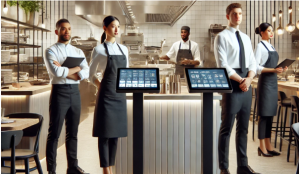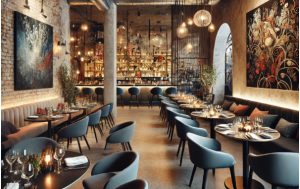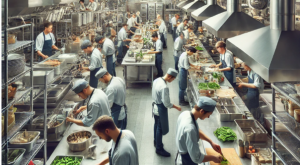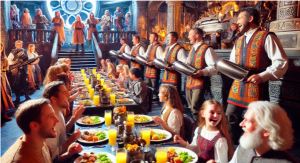The restaurant industry is a dynamic and competitive arena where passion meets practicality. While you may have a groundbreaking culinary concept, transforming it into a thriving business requires careful planning and strategy. A well-crafted restaurant business plan serves as your roadmap to success, helping you secure funding, navigate challenges, and stand out in a crowded market.
As we move into 2024, the restaurant landscape continues to evolve rapidly. This comprehensive guide will equip you with the latest trends, data-driven insights, and proven strategies to create a business plan that not only gets you funded but also fast-tracks your dream restaurant into reality.
Understanding the Current Restaurant Landscape
Before diving into the specifics of your business plan, it’s crucial to have a firm grasp of the current state of the industry. Here are key trends and data points to consider:
1. The Delivery and Online Ordering Revolution

The online food ordering market is projected to reach a staggering $223.7 billion globally by 2027, according to Statista. This explosive growth means that any viable restaurant concept must factor in robust delivery and online ordering capabilities. Your business plan should detail how you’ll integrate these services, whether through in-house systems or partnerships with third-party platforms like DoorDash and Uber Eats.
2. Sustainability as a Core Value
Environmental consciousness is no longer just a trend—it’s an expectation. Nielsen reports that 68% of global consumers are willing to pay more for sustainable brands. Your business plan should highlight eco-conscious practices such as:
- Sourcing ingredients from local, sustainable suppliers
- Implementing food waste reduction strategies
- Using compostable or recyclable packaging
- Energy-efficient kitchen equipment and practices
3. Technology-Driven Efficiency

Technology is revolutionizing restaurant operations from self-ordering kiosks to advanced kitchen management systems. Your plan should explore how you’ll leverage technology to:
- Streamline ordering and payment processes
- Optimize kitchen workflows and reduce wait times
- Enhance customer relationship management (CRM)
- Gather and analyze data for continuous improvement
4. Targeted Niche Marketing
Success in the restaurant industry often comes from catering to a specific audience or filling a gap in the market. Your business plan should clearly define your target demographic and explain how your concept meets their unique needs and preferences.
Crafting Your Restaurant Business Plan: A Comprehensive Guide
Now that we’ve established the industry context, let’s break down the essential components of a winning restaurant business plan:
1. Executive Summary

This is your elevator pitch—a concise yet compelling overview of your restaurant concept. In no more than two pages, address:
- Your restaurant’s unique value proposition
- Target market and competitive landscape
- Brief financial projections and funding needs
- Management team highlights
- Long-term vision and growth strategy
2. Company Description
Dive deeper into your restaurant’s identity:
- Cuisine type and overall concept
- Mission statement and core values
- Legal structure and ownership details
- Location strategy (if determined)
- Hours of operation and service style
3. Market Analysis

Demonstrate your thorough understanding of the industry and your specific market:
- Local demographic data and dining trends
- Competitor analysis (direct and indirect)
- SWOT analysis (Strengths, Weaknesses, Opportunities, Threats)
- Regulatory environment and compliance requirements
4. Menu and Pricing Strategy
- Showcase signature dishes and overall menu structure
- Explain your pricing strategy and profit margins
- Highlight any unique dietary considerations (e.g., vegan, gluten-free options)
- Describe your sourcing philosophy (local, organic, etc.)
5. Management Team

Introduce the key players who will drive your restaurant’s success:
- Highlight relevant industry experience and qualifications
- Outline roles and responsibilities
- Identify any skills gaps and plans to address them
- Showcase passion and commitment to the project
6. Marketing and Sales Strategy
Detail your plan to attract and retain customers:
- Brand positioning and messaging
- Digital marketing tactics (social media, influencer partnerships, SEO)
- Traditional marketing methods (local events, print media)
- Customer loyalty programs and retention strategies
- Sales forecasts and growth projections
7. Financial Projections

This section is crucial for securing funding. Provide realistic and well-researched:
- Startup costs and capital requirements
- Projected profit and loss statements (3-5 years)
- Cash flow forecasts
- Break-even analysis
- Return on investment (ROI) projections
8. Operations Plan
Outline the day-to-day functioning of your restaurant:
- Staffing requirements and organizational structure
- Inventory management and supplier relationships
- Quality control measures
- Customer service protocols
- Technology integration (POS systems, reservation software, etc.)
9. Design and Ambiance

Describe how your restaurant’s physical space will enhance the dining experience:
- Interior design concept and layout
- Lighting and music considerations
- Outdoor seating or special features
- How the design supports your brand identity
10. Risk Assessment and Mitigation
Identify potential challenges and outline strategies to address them:
- Economic downturns or unexpected events (e.g., pandemics)
- Supply chain disruptions
- Labor shortages or high turnover
- Changing consumer preferences
- Increased competition
Beyond the Basics: Innovative Strategies for Modern Restaurants
To truly stand out in 2024, consider incorporating these cutting-edge concepts into your business plan:
1. Ghost Kitchens and Virtual Brands

Explore the potential of delivery-only models to reduce overhead costs and tap into the booming online ordering market. Consider:
- Launching a virtual brand alongside your main concept
- Partnering with existing ghost kitchen facilities
- Developing a hybrid model with limited dine-in and a strong delivery focus
2. Experiential Dining

Create memorable experiences that go beyond just great food:
- Themed events or pop-up concepts
- Interactive cooking classes or chef’s table experiences
- Augmented reality (AR) menu presentations
- Collaborations with local artists or performers
3. Hyper-Local and Sustainable Sourcing

Double down on sustainability and community connections:
- Develop relationships with local farmers and producers
- Implement on-site herb gardens or hydroponic systems
- Highlight “farm-to-table” or “zero-waste” initiatives in marketing
- Consider vertical integration (e.g., owning a small farm or production facility)
4. Data-Driven Decision Making
Leverage technology to gather and analyze customer data:
- Implement AI-powered menu optimization
- Use predictive analytics for inventory management
- Personalize marketing efforts based on customer preferences
- Continuously refine operations based on real-time feedback
Conclusion: Crafting a Dynamic and Fundable Restaurant Business Plan
By incorporating these trends, data-driven insights, and innovative strategies, you’ll create a restaurant business plan that not only secures funding but also positions your venture for long-term success. Remember, your plan should be a living document—revisit and revise it regularly as your restaurant evolves and the industry landscape shifts.
As you embark on this exciting journey, consider seeking guidance from experienced professionals. Business plan consultants near me can provide valuable insights and help refine your strategy. With a well-researched, comprehensive, and forward-thinking plan in hand, you’ll be well-equipped to turn your culinary vision into a thriving reality in 2024 and beyond.




